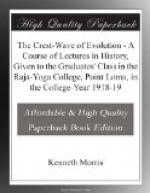A revolution took place in architecture in this age: the Buddhist style was abandoned, for something which, says Mrs. Flora Annie Steel: *
“.....more ornate, less self-evident, served to reflect the new and elaborate pretensions of the priesthood.”
------ * To whose book India through the Ages, I am indebted for these facts concerning the Gupta Age. ------
It is summed up, says Mrs. Steel, in the words:
“...._cucumber and gourd_... tall curved vimanas or towers, exactly like two thirds of a cucumber stuck in the ground and surmounted by a flat gourd-like ‘amalika.’ .... Exquisite in detail, perfect in the design and execution of their ornamentation, the form of these temples leaves much to be desired. The flat blob at the top seems to crush down the vague aspirings of the cucumber, which, even if unstopped, must erelong have ended in an earthward curve again.”
The age culminated in the next reign, that of Chandragupta II Vikramaditya. Heaven knows how to distingusih between him and his half-mythological namesake of B.C. 58 and Ujjain. Very possibly the Nine Gems of Literature and Kalidasa and The Ring of Sakoontala belong to this reign really. At any rate it was a wonderful time. Fa-hien, the Chinese Buddhist traveler, obligingly visited India during its process, and left a picture of conditions. Personal liberty, says Mrs. Steel, was the keynote feature. There was no capital punishment; no hard pressure of the laws; there were excellent hospitals and charitable institutions of all sorts.—We are to see in the whole age, I imagine, a period of great brilliance, and of humaneness resulting from eight centuries of the really civilizing influence of Buddhism: far higher conditions than you should have found elsewhere to east or west at that time;—and also, the moment when the impulse of culture had reached its outward limit, and the reaction against the spiritual sources of culture began.
Chandragupta Vikramaditya reigned until 413; Kumaragupta, great and successful also, until 455. Then, thirteen decades after Samudragupta’s accession, came Skandagupta; and with him, the White Huns. He defeated them on a large scale in the fifties; but they returned again and again to the attack; during the next thirty years their pressure was breaking up the empire; till when Skandagupta died in 480, it fell to pieces.
XXIII. “THE DRAGON, THE APOSTATE, THE GREAT MIND”
The time is the middle of the fourth century A.D. The top of the Crest-Wave is in India, now the greatest country in the world. The young Samudragupta, about thirty years old now, has been filling the whole peninsula with his renown as warrior, poet, conqueror, patron of arts and letters, musician. The Hindus are a busy and efficient people, masterly in this material world. Their colonies are spread over Java, Sumatra, and the other islands; Formosa (think




